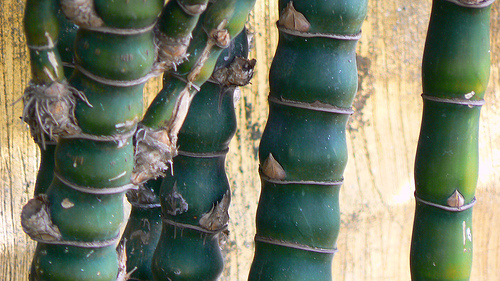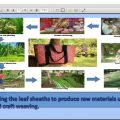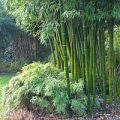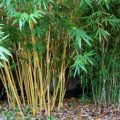Bending towards farmers success. Other than being a grass, there are other unknown facts about bamboo. For example, not many have heard of its use as embellishments in landscaping. Using bamboo as an ornamental plant is only a secondary consideration among Filipino bamboo farmers unlike in Japan, China, and other Asian countries, until recently when enterprise owners noticed the beauty of the humble plant.

Nursery operators in Laguna and Bulacan discovered the lucrative business of producing ornamental bamboo.
At present, there are many species of ornamental bamboos in the country. The influx of these ornamental bamboos was brought about by the importation of the Environment Research and Development Bureau (ERDB) through its bambusetum establishment project and introduction of new species by garden enthusiasts. Many of these unique bamboo species are kept as prized possessions in private gardens of collectors.
Among the ornamental bamboos which found their way in the Philippines are kawayan dilaw (Green Stripe Bamboo), wamin (Buddha’s Belly Bamboo), pole bamboo (Monastery bamboo), Taiwan bamboo, Chinese dwarf bamboo, honshou-chiku, running bamboo (fishpole, phoenix or fairyland bamboo), black bamboo, okinas-dake, kamuro-saza, golden bamboo (buhong dilaw), okame-zasa, and utod.
Yet, one does not simply grow ornamental bamboos.
There are ways which are proven by science as the effective methods of propagation like culm cutting, marcotting, and division or offset. Division or offset method is commonly used and widely accepted in the market.
Through division or offset method for Thyrsostachys siamensis Gamble, newly developed bamboo plant dubbed as ‘junior’ is separated from the clump having 3-5 culms. The junior comes from shoots that is allowed to grow its height and fully develop its leaves and branches before being separated from the clump.
Once separated, it is planted on the ground to flourish and produce shoots, supported by stakes. Continuous production of shoots in a year will result in the development of a clump.
Whenever there is demand, bamboo producer may ball out or lift the clump even with just two stems or culms. The usual practice, though, is to let the clump have 5 or more culms before applying two stem-division, which is done by balling the whole clump or a part of it. The unballed part is left to grow more shoots for a continuing macroproliferation.
Meanwhile, the propagation of Australian bamboo by division or offset is essentially similar with that of Thyrsostachys siamensis but differs only in the size of the division. For Australian bamboo, the division may only contain 2-3 culms, a part of which is left behind to regenerate.
The division or offset method is likewise used for yellow or golden buho but requires a different approach. The bamboo clump is left to develop in-ground at the growing area until it reaches 10 culms before separated into five culms per division.
The nursery cultural practices include potting of separated propagules, providing support stakes to newly potted plants, application of rooting hormones and fertilizers, pest and disease control.
Immediately after separation, each plant is potted in a 12” polyethylene bag with a medium composed of 1:1 rice hull and coconut coir or 2:2:1 rice hull, coconut coir, and soil. No pruning and cutting may be done in a newly separated plant. Support the plant with bamboo poles and plastic twines to minimize disturbance. This will facilitate the development of root system and recovery from balling and separation.
The application of rooting hormones will increase absorption of water and nutrients needed for growth and development. A month after potting, fertilizer application is recommended for the plants to grow luxuriantly and become vigorous and attractive to buyers. Urea and ammonium at 10-20 g/pot are the types of fertilizers normally used. Not much pests and diseases are reported on ornamental bamboos but only caterpillar and locusts are observed.
The potted plants are good for selling after one and a half to a couple of months after potting and tending in the nursery. Whenever the plants are not immediately sold, new shoots can come up and become culms in the future. In this case, the new stems are again separated and tended until they will be ready for sale.
The research and development initiative on ornamental bamboo manifests the goal of the Council and the Department of Science and Technology as a whole in maximizing science and technology potentials to attain sustained growth.
PCAARRD’s commitment to Outcome One will be showcased by the Council in its participation to the National Science and Technology Week (NSTW) on July 24-28 at SMX Mall of Asia, Pasay City.
“Outcome One serves as DOST’s blueprint towards alleviating poverty in the agriculture and aquatic sectors as part of the government’s social contract with our people,” said DOST Secretary Mario G. Montejo in his message during one of the events of the Council.
The 2015 NSTW adopts the theme Philippines: A Science Nation Innovating for Global Competitiveness.
PCAARRD, on the other hand, adopts the theme Strategic Industry S&T Program for Agri-Aqua Growth (SIPAG) ni Juan to bolster PCAARRD’s commitment to Outcome One which the Council pursues, through its Industry Strategic S&T Program (ISPs), among other programs, hence the tagline SIPAG ni Juan.
by Mereyll Kyla P. Irader






